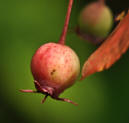 That
crabapple tree
hanging over the sidewalk sure looks great in bloom but
the fruit makes a real mess when they drop to the cement
and rot. This is a classic example of the wrong plant in
the wrong place. That
crabapple tree
hanging over the sidewalk sure looks great in bloom but
the fruit makes a real mess when they drop to the cement
and rot. This is a classic example of the wrong plant in
the wrong place.
As always, there are
several options to consider:
-
Replace the Tree - This
is a drastic step and should only be considered as a
last resort. However, if the fruit is continually
brought onto your nice white carpeting by everyone
who visits...well.
-
Hand Thinning - This
would be tedious but may be an option if you have
just one small tree in the wrong place. Enjoy the
blooms but as soon as the petals drop off, either
hand pick or cut off the small, developing fruit.
-
Chemical Thinning -
Certain plant
hormones will cause fruit to drop off
or not set in the first place. This is commonly done
in commercial orchards to prevent a process called
alternate bearing where a tree bears a heavy crop
one year and a light one the following year. By
thinning part of the crop each year, they get a nice
crop each season.
Several chemicals are used for this purpose
including Naphthaleneacetic
acid (NAA), Naphthaleneacetamide (NAD), maleic
hydrazide (MH-30), chiorophenoxy propionic (3-CP) and dinitro-ortho-cresol (dinitro).
Be aware that these products are not often available
in the small amounts that the homeowner would need
for one or two crabapple trees. They are usually
sold in large volumes for commercial orchardists.
The insecticide carbaryl (Sevin) also causes
abortion of newly developing fruit. However, it
would have to be sprayed during the late phases of
bloom and this is when honeybees are still working
the flowers. Bees are very, very sensitive to
carbaryl so this is not a recommended procedure. We
need all the
honeybees we can get!
With any of the chemical treatments, timing and the
concentration of the spray mixture are keys. Follow
the instructions on the product to the letter to
have any success. Even in the best of times, you
probably will not get 100% reduction of fruiting. It
just doesn't work that completely or that reliably.
Weather is also a factor that can cause a variation
in success.
-
Prevention - If you
don't already have the tree in the landscape,
avoiding the problem is still an option. Female
Ginkgo trees produce a fruit that becomes very
smelly when it drops to the ground. For this reason,
reputable nurseries will only sell male plants. Some
tree cultivars are seedless. There are literally
hundreds of cultivars of crabapples in the market.
Some are heavy fruiting varieties while others set
small amounts of fruit. Choose the cultivar that
fits your site needs.
The over production of
fruit may be a problem but
failure
to bloom is also a concern.
|



